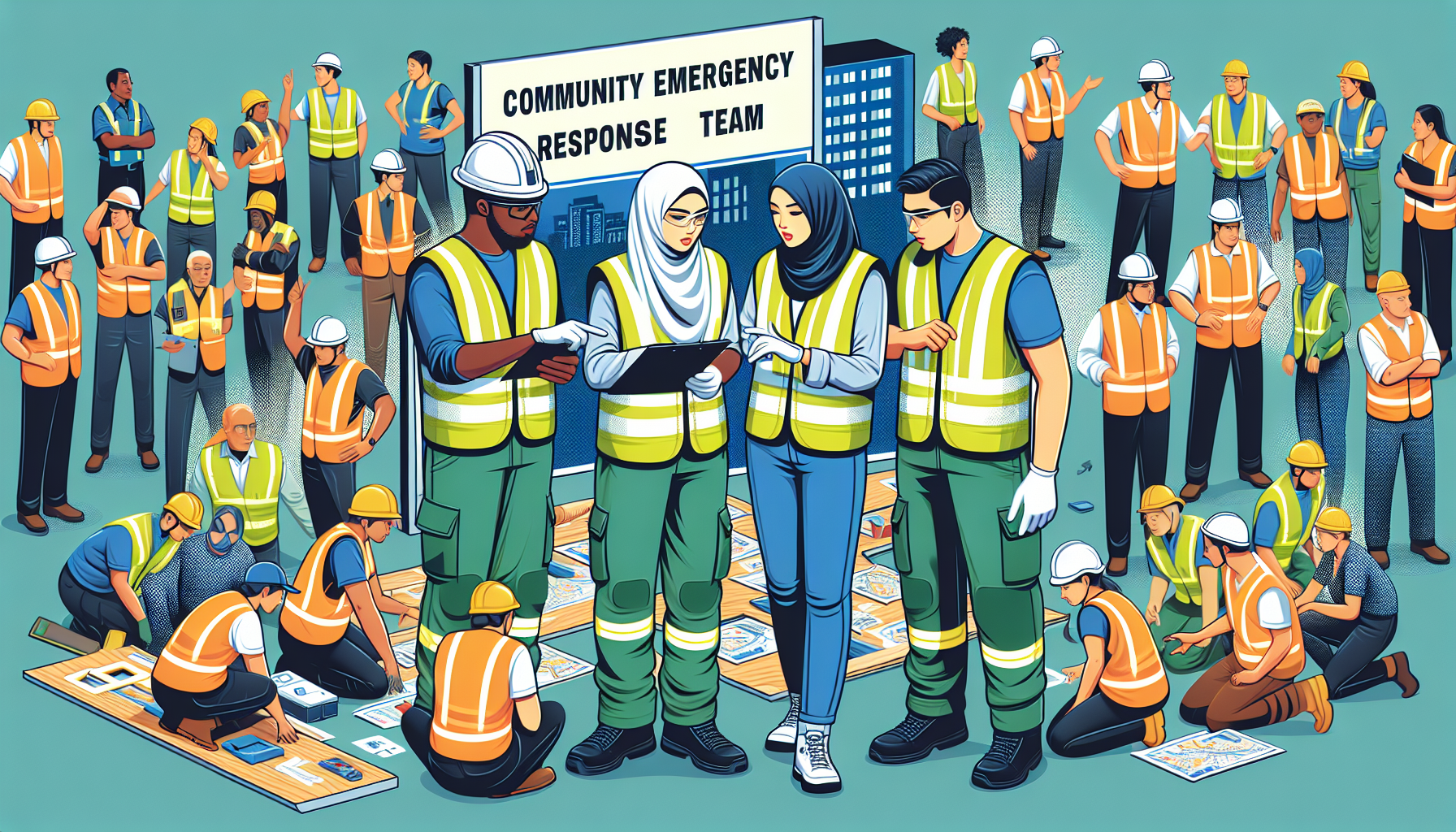Imagine a world where you and your neighbors are equipped with the skills and knowledge to handle any emergency that comes your way. Picture a community united and prepared, ready to lend a helping hand during crises. Building a Community Emergency Response Team (CERT) is not only possible, but it’s also a proactive step towards ensuring the safety and well-being of everyone around you. Whether you live in a bustling city or a quiet suburb, this article will guide you through the process of creating your own CERT, empowering you and your community to be resilient in the face of adversity. It’s time to come together and make a difference.
Identify the Need for a Community Emergency Response Team
Assess the current emergency preparedness in your community
Before building a Community Emergency Response Team (CERT), it is crucial to assess the current emergency preparedness in your community. Take a closer look at the existing resources, infrastructure, and plans in place to address emergencies. Evaluate how well-equipped your community is to handle various types of disasters. This assessment will help you identify any gaps or areas where improvements can be made, ultimately highlighting the need for a dedicated CERT.
Evaluate potential risks and vulnerabilities
Next, it is important to evaluate the potential risks and vulnerabilities that your community may face. Consider natural disasters such as hurricanes, earthquakes, floods, or wildfires that are common in your area. Additionally, assess any man-made risks like chemical spills, terrorist attacks, or power outages. By understanding these risks, you can identify the specific skills and resources needed for an effective CERT.
Determine the need for a Community Emergency Response Team (CERT)
Based on the assessment of your community’s emergency preparedness and the evaluation of potential risks, determine whether establishing a CERT is necessary. Consider the size, population, and unique characteristics of your community. If there are gaps in emergency response capabilities, a CERT can provide vital support during disasters, ensuring a timely and coordinated response. A CERT can bridge the gap between professional emergency responders and the community, enhancing overall emergency preparedness and resilience.
Research and Gather Information
Study successful CERT programs in other communities
To build an effective CERT, it’s important to gather information and study successful CERT programs in other communities. Learn from their experiences, best practices, and lessons learned. Look for communities that have faced similar challenges or have successfully implemented CERT programs. These case studies can provide valuable insights and serve as a model for your own CERT program.
Contact local emergency management agencies
Reach out to your local emergency management agencies to gather information about existing emergency response initiatives. These agencies will have knowledge and expertise in disaster preparedness and response. Seek their guidance on establishing a CERT and understand any regulations or requirements that need to be considered. The experience and support of these agencies can greatly enhance your CERT program’s effectiveness.
Connect with existing CERTs for guidance and support
Connecting with existing CERTs can offer valuable guidance and support as you establish your own team. Reach out to nearby communities or organizations that have well-established CERT programs. They can provide insights on training, recruitment strategies, and developing partnerships with local emergency response agencies. Building a network with other CERTs allows for knowledge exchange and can contribute to the overall success of your CERT program.

Recruit and Organize Team Members
Raise awareness about the CERT program in your community
To recruit team members for your CERT, it’s essential to raise awareness about the program in your community. Use various communication channels such as social media, local newspapers, community bulletin boards, and word-of-mouth to spread the word. Highlight the importance of community involvement in emergency preparedness and emphasize the benefits of joining the CERT.
Develop a recruiting strategy
Develop a recruiting strategy to attract individuals who are willing to dedicate their time and efforts to the CERT program. Consider reaching out to local organizations, businesses, and community groups who may have members interested in volunteering as CERT team members. Tailor your strategy to target individuals with a diverse range of skills and backgrounds to ensure a well-rounded team.
Conduct interviews and select team members
Once you have potential candidates, conduct interviews to assess their suitability for the CERT program. Look for individuals who demonstrate a willingness to learn, collaborate, and show a genuine commitment to serving the community during emergencies. Select team members who possess a mix of skills and abilities that align with the needs of your community and the CERT program.
Assign roles and responsibilities within the team
Assigning roles and responsibilities within the CERT team is essential to ensure effective coordination and efficient response during emergencies. Identify individuals who show leadership potential and delegate specific tasks such as communication, first aid, search and rescue, logistics, and documentation. By clearly defining roles, each team member can contribute their unique skills and expertise, creating a well-functioning CERT.
Training and Education
Provide basic CERT training to team members
Once your CERT team is organized, it is crucial to provide them with basic CERT training. This training equips team members with the necessary knowledge and skills to respond effectively in emergency situations. The training typically covers disaster preparedness, fire safety, disaster medical operations, light search and rescue, and team organization. FEMA offers a standardized CERT training curriculum that you can utilize or adapt according to your community’s specific needs.
Arrange specialized training sessions
In addition to basic CERT training, consider arranging specialized training sessions to further enhance the skills of your team. For example, organize training sessions on specific disaster scenarios or provide training in advanced first aid or crisis communication. Collaborate with local experts or emergency response agencies to provide specialized training opportunities that align with your community’s needs and vulnerabilities.
Organize regular drills and exercises
To ensure that your CERT is well-prepared and able to respond effectively during emergencies, organize regular drills and exercises. These simulated scenarios allow team members to practice their skills, test their equipment, and improve their response coordination. Conduct drills that simulate different emergency situations and evaluate the CERT’s performance. Use these exercises to identify areas for improvement and enhance the overall effectiveness of your team.
Promote ongoing education and skill development
Encourage ongoing education and skill development within your CERT team. Offer opportunities for team members to attend relevant workshops, seminars, and conferences. Foster a culture of continuous learning by sharing new information, resources, and best practices. By promoting ongoing education and skill development, you ensure that your CERT remains up-to-date with current emergency response techniques and can adapt to evolving challenges.

Establish Communication Channels
Set up a dedicated communication system for the CERT
Establishing a dedicated communication system for your CERT is crucial to ensure effective and efficient coordination during emergencies. Depending on the size and resources of your community, this communication system can range from simple radios or walkie-talkies to more advanced technologies like mobile apps or web-based platforms. Choose a system that is reliable, easily accessible, and compatible with the communication platforms used by local emergency response agencies.
Establish protocols for effective communication during emergencies
Along with the communication system, it is essential to establish protocols for effective communication during emergencies. Clearly define how information should be shared, who the primary points of contact are, and the procedures for reporting and documenting incidents. These protocols will facilitate seamless communication between CERT team members, local emergency response agencies, and other relevant stakeholders.
Ensure compatibility with local emergency response agencies
Collaboration with local emergency response agencies is crucial for effective disaster response. Ensure that your CERT’s communication system and protocols are compatible with those used by these agencies. This compatibility will enable efficient information sharing, coordination, and integration of your CERT’s efforts with the broader emergency response system. Collaborate with local agencies to establish clear communication channels and ensure seamless cooperation during emergencies.
Collaboration with Local Emergency Response Agencies
Reach out to local fire, police, and emergency medical services
Building strong relationships and partnerships with local fire, police, and emergency medical services is vital for a successful CERT program. Reach out to these agencies to introduce your CERT and express your interest in collaborating. Understand their roles, responsibilities, and protocols during emergencies. Show how your CERT can complement their efforts and offer valuable support. Collaborative partnerships with these agencies will enhance emergency response capabilities in your community.
Establish partnerships and clear communication protocols
Once you have reached out to local emergency response agencies, focus on establishing partnerships and clear communication protocols. Regularly communicate and collaborate with these agencies to maintain open lines of communication, exchange information, and coordinate joint planning efforts. By aligning your CERT’s response actions with those of local emergency response agencies, you can enhance overall preparedness and ensure a coordinated response during emergencies.
Coordinate joint training exercises and response planning
To further strengthen your collaboration with local emergency response agencies, coordinate joint training exercises and response planning sessions. These activities allow for the integration of CERT members and emergency response agency personnel, fostering teamwork and shared understanding. Conduct joint drills, tabletop exercises, or mock disasters to test and improve the coordination between your CERT and the local agencies. Use these exercises to identify areas for improvement and refine response strategies.

Create a Response Plan
Conduct a comprehensive risk assessment
To create an effective emergency response plan, conduct a comprehensive risk assessment specific to your community. Evaluate the potential hazards, vulnerabilities, and resources available. Identify the areas or populations that are most at risk during different types of emergencies. Analyze the impact each hazard may have on your community and prioritize response actions accordingly. A thorough risk assessment will serve as the foundation for developing an appropriate response plan.
Develop an emergency response plan specific to your community
Based on the risk assessment, develop an emergency response plan that is specific to your community’s needs and vulnerabilities. The plan should outline the procedures, responsibilities, and resources for various scenarios. Include protocols for evacuation, sheltering, medical support, and communication. Ensure that the plan accounts for the unique characteristics and challenges of your community. Regularly review and update the plan as necessary to reflect any changes in resources, infrastructure, or risks.
Include standard operating procedures and guidelines
To ensure consistency and efficiency in your CERT’s response efforts, include standard operating procedures (SOPs) and guidelines in your emergency response plan. SOPs provide step-by-step instructions for specific tasks or actions, ensuring that team members know what to do in different situations. Guidelines offer general principles or best practices that guide decision-making during emergencies. SOPs and guidelines will streamline response efforts, minimize confusion, and improve overall effectiveness.
Review and revise the plan periodically
Emergency response plans should be reviewed and revised periodically to ensure their relevance and effectiveness. As your community evolves, so do the risks and resources available. Regularly assess your plan and make updates based on lessons learned from drills, exercises, and real-life incidents. Solicit feedback from team members, local emergency response agencies, and other stakeholders. By maintaining an up-to-date and adaptable response plan, your CERT will be better prepared to face future emergencies.
Equip the CERT with Essential Supplies
Compile a list of necessary equipment and supplies
An essential aspect of building a CERT is equipping the team with necessary equipment and supplies. Compile a comprehensive list of items required to support your CERT’s response efforts. These may include first aid kits, personal protective equipment, communication devices, rescue tools, lighting, and food/water supplies. Identify the quantity and quality needed to effectively carry out CERT duties. Consider factors such as the size of your team, the vulnerabilities of your community, and the potential duration of emergencies.
Seek funding or donations to acquire necessary resources
Assembling the required equipment and supplies can be financially challenging. Seek funding or donations from local businesses, community organizations, or government agencies to acquire the necessary resources. Explain the importance of the CERT program, its positive impact on community preparedness, and how the donated funds or resources will directly benefit the community during emergencies. Emphasize the value of community involvement and unity in building a resilient community.
Maintain an inventory of equipment and ensure regular maintenance
Once you have acquired the necessary equipment and supplies, maintain an inventory to keep track of their availability and condition. Regularly check and maintain the equipment to ensure that it is in proper working order. Establish a system for restocking and replacing items as needed. Training team members on the proper use and storage of equipment will help prolong its lifespan. By regularly maintaining your inventory, you can ensure that your CERT remains well-prepared and ready to respond when emergencies strike.

Build Community Relationships
Engage with local organizations and community groups
Building strong community relationships is crucial for the success of your CERT program. Engage with local organizations and community groups to foster collaboration and participation. Attend community meetings, events, and workshops to introduce your CERT and educate others about the importance of emergency preparedness. Establish partnerships with organizations that can support your CERT’s activities or provide resources. By working together, you can create a unified and resilient community.
Host community meetings and workshops
Host regular community meetings and workshops to promote dialogue, share information, and provide opportunities for community members to get involved. Invite guest speakers, subject matter experts, or emergency response professionals to present on topics related to emergency preparedness, response techniques, or risk mitigation. Encourage community members to ask questions, voice concerns, and actively participate in the discussions. These meetings and workshops will not only educate the community but also strengthen their connection to the CERT program.
Promote collaboration and participation
Actively promote collaboration and participation within the community. Encourage community members to join the CERT program and actively engage in its activities. Foster a sense of ownership and responsibility among residents by emphasizing that community preparedness is a collective effort. Provide opportunities for community members to contribute their skills, knowledge, and resources to enhance overall emergency response capabilities. By promoting collaboration and participation, you build a strong sense of community resilience.
Encourage community members to join the CERT program
Encourage community members to join the CERT program by highlighting the valuable role they can play in ensuring community safety during emergencies. Emphasize the training and skills development opportunities that come with being a CERT member. Reach out to diverse segments of the community and address any barriers or concerns that may discourage participation. By actively recruiting and involving a diverse group of community members, your CERT will be representative of the entire community and better equipped to address its unique needs.
Activate and Deploy the CERT
Activate the CERT during emergencies or disaster situations
When emergencies or disaster situations occur, it is crucial to activate your CERT. Ensure that team members are promptly notified and informed about the nature of the emergency. Activate your CERT response plan, which should clearly outline the steps and protocols to be followed during activation. Designate a central location or command post where team members can gather and receive instructions. Timely activation of the CERT is vital to ensure a rapid response and effective coordination.
Follow the established response and communication protocols
During an emergency, it is essential to follow the response and communication protocols that have been established. Adhere to the standard operating procedures and guidelines outlined in the response plan. Use the designated communication channels to share information, report incidents, and coordinate with other CERT members and emergency response agencies. By following established protocols, you ensure a coordinated and efficient response that maximizes the impact of your CERT’s efforts.
Deploy CERT members to assist in emergency response efforts
Once activated, deploy CERT members to assist in emergency response efforts based on their assigned roles and responsibilities. This may involve tasks such as conducting initial damage assessments, providing first aid or medical support, assisting with search and rescue operations, or supporting communication and logistics. Ensure that team members are adequately briefed and equipped before being deployed. Regularly communicate and coordinate with local emergency response agencies to ensure seamless integration of CERT efforts into the overall response.
Building a Community Emergency Response Team (CERT) is an important step towards creating a resilient and prepared community. By assessing the current emergency preparedness, evaluating potential risks, and determining the need for a CERT, you can lay the groundwork for an effective response program. Through research, recruitment, training, and collaboration with local emergency response agencies, you can establish a capable and coordinated CERT. By creating a comprehensive response plan, equipping your team, engaging the community, and activating the CERT during emergencies, you will enhance your community’s emergency preparedness and ensure a timely and effective response when disaster strikes. Remember, building a CERT requires commitment, collaboration, and ongoing dedication to the safety and well-being of your community.


